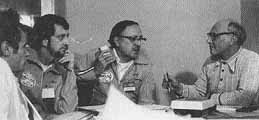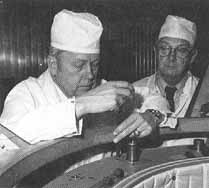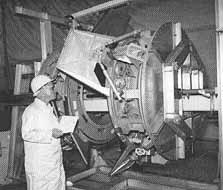
Docking System - Review
When the meeting resumed at 2:15, Bob White spoke for Group 3. After reviewing the major elements of the docking hardware, he summarized the recent test history of that equipment. Following the fourteen-week mate and dynamic development tests conducted in 1973, three more major test activities had been carried out successfully. The first of these, the mate and dynamic qualification testing, had been done in Houston (1 July-5 September 1974) to certify physical, functional, and operational compatibility, to verify the integrity of the docking systems under maximum docking loads; and to observe the operation of the guide ring and capture hooks on the active system. In two parts, the examination had covered the mate check and the functional test of the hardware when fit together under ambient temperatures. Subsequently, the hardware was placed on the dynamic docking vehicle simulator to test it at high (70°C) and low (-40°C) temperatures. The docking systems were run together in a conglomerate of experimental dockings to determine the operation of the systems under both normal and worst-possible circumstances. Roll, pitch, yaw, and axial misalignments were combined with various initial contact velocities to determine how this equipment, built to the same specifications as the flight hardware, could be expected to function in space.
[294] Only one problem developed during these tests. When the U.S.S.R. system went through the active phase of the cold temperature test, the resulting data did not agree with that obtained either during the earlier development tests or with the Soviet mathematical analysis. When the hot temperature test was run, the testers noticed oil leaking from the attenuator rods. Upon examination, they discovered that an anti-corrosion grease placed in the hollow rods to prevent rusting had not been removed. The grease had gummed up some operating parts. The second Soviet qualification unit did not have the grease problem, nor did the flight units back in Moscow. Once the errant lubricant was removed from the unit in Houston, it functioned satisfactorily. Otherwise, the U.S. and U.S.S.R. systems performed as expected.16
When he turned to the pre-flight compatibility verification test of the actual flight docking systems, White noted one major alteration that had been made during the test. The Americans had altered the alignment pins and sockets on their docking gear. Group 3 had recognized a potential problem with the existing alignment pins and sockets in October 1974 during the acceptance testing of the docking system at Rockwell International. This exercise, designed to prove the flight hardware was acceptable prior to the government's paying for it, tested the docking systems in a special horizontal fixture, which took into account the absence of earth's gravity in space. Guide rails with roller bearings kept the extended active guide and ring from drooping from its own weight. These guide rails were supposed to align the two docking gear, but there was a slight misalignment. When the two systems were brought together and capture was achieved, the active system could not fully retract to achieve structural latching. A gap of about 6 millimeters existed, a small distance but enough to prevent a transfer in space. Once the Rockwell engineers discovered that the guide rails were not aligning the two systems properly, they adjusted them and tried the exercise again. The second time there was no problem; there had been no difficulty with the prime flight docking system.17
But this experience at Rockwell left Glynn Lunney with a nagging concern. He decided that the issue required further analysis. Meanwhile two of the docking systems were shipped to Moscow for the compatibility verification tests. Bob White and his eleven technical specialists followed. Once Rockwell completed their analytical work on the so-called friction lock problem, Lunney called White to discuss the results. In Moscow, White and his colleagues, the "Dirty Dozen" as they called themselves, disagreed with Rockwell's findings, which indicated that friction lock was a problem that could influence the conduct of the flight. White argued that Rockwell's assumptions were too severe. The circumstances as described by Earl...
|
A NASA inspector observes mating of American Docking Systems 4 and 5 on the horizontal test fixture at Rockwell International factory in Downey, California. |
|
 |
 |
|
V. S. Syromyatnikov, R. D. White, E. N. Harrin, and Professor Bushuyev, in the latter's Moscow office, discuss the need to change the alignment pin and socket in the American docking system on the telephone with Glynn Lunney in Houston, November 1974. In December Ray Larson and C. E. Kindelberger of Rockwell International fly to Moscow and install the modified alignment pin. |
...Holman, who conducted the analysis, were unlikely to occur in space. White also opposed changing the flight hardware at that very late date because the alterations were likely to create real problems while attempting to solve a possible one. Both sides had agreed that following the qualifications tests the design of the "interfacing hardware" (i.e., the docking system) would be frozen. No further changes should be made.
Nevertheless, Lunney, in consultation with NASA Headquarters and Rockwell, decided that the pins and sockets had to be altered. The agency saw the following hazard:
The potential pin and socket binding problem of both docking systems can lead to the stall of the guide ring drive in an active USA docking which can produce an overload in one of the three cables retracting the ring, which in [296] turn can lead to its failure. Failure of a guide ring retract cable will result in the inability to further use the US docking systems either in the active or passive mode and, as a consequence, the failure to complete the basic purpose of the flight.18
As a consequence, Lunney telexed Professor Bushuyev and explained the problem to him.19 (See box below.)
While Rockwell manufactured the new pins and sockets, Bob White discussed the problem with V. S. Syromyatnikov and Professor Bushuyev. White believed that "Vladimir was sympathetic to our problem and agreed that the change was necessary."20 Without Syromyatnikov's understanding, it would have been very difficult to sell Bushuyev on the alteration. The only constraint the Soviets placed upon the Americans was that the U.S.S.R. pins and sockets would remain unchanged.
The USSR docking system guide pin and socket are installed from the back side of the structural ring front flange. In addition, the socket is installed before the docking system differential drive assembly is installed. Therefore, the socket removal and installation requires substantial docking system disassembly and readjustment of the kinematic coupling of six attenuator rods with the differential drive assembly which is a laborious operation.
Considering that all three USSR flight docking systems are assembled and in readiness for the Preflight Mate Test . . . the docking system rework is impossible without a review of the schedule of preparing the spacecraft for flight and launch date itself.21
White and Syromyatnikov agreed that it would be sufficient to change only the U.S. pin and socket. This understanding was officially recognized by Lunney and V. A. Timchenko in their telephone conversation of 19 November.22
To accomplish the modification in the shortest time, White and Syromyatnikov modified the test plans and worked out procedures to test the new components while waiting for Arnold D. Aldrich, Lunney's Deputy, and Ray F. Larson, Rockwell's command and service module manager, to arrive. Once in Moscow, Aldrich worked with the Soviets to draft minutes covering the changes and establishing a test plan for an additional examination of the modified system in January 1975 at Downey. Ray Larson and Earl Holman worked with the "Dirty Dozen" to complete the changes. The American Group 3 delegation divided into two groups; the "Mod Squad" made the alterations on one docking system, while the "Test Team" continued testing the other system. Whereas Rockwell had predicted that it would take four days to complete the modifications, the specialists actually needed only 4 to 5 hours for each docking system. Total time lost...
|
TO: PROFESSOR K. BUSHUYEV ACADEMY OF SCIENCES OF THE USSR 14 LENINSKI PR MOSCOW, V-71, USSR UNCLAS IN REPLY TO PA-LSN-21 3-74 MR. ALDRICH MENTIONED TO YOU DURING THE NOVEMBER 5 TELECON THAT WE WERE SOMEWHAT CONCERNED ABOUT THE POSSIBILITY THAT UNDER CERTAIN CONDITIONS IT MIGHT BE POSSIBLE FOR THE CURRENT DOCKING SYSTEM ALIGNMENT PIN AND SOCKET DESIGN TO BIND AND PREVENT FINAL RETRACTION. WE HAVE JUST COMPLETED A SERIES OF TESTS AND HAVE CONCLUDED THAT BINDING OF A U.S. PIN IN A U.S. SOCKET CAN OCCUR UNDER THE FOLLOWING CONDITIONS: A SIDE LOAD ON THE PIN ON THE ORDER OF 300 LBS [136 kg] OR GREATER WILL CAUSE BINDING WHEN A HESITATION AND RETRACTION OF THE PIN FROM THE SOCKET OF 0.020 INCHES [0.5 mm] OCCURS JUST AS THE PIN IS ENTERING THE CYLINDRICAL PORTION OF THE SOCKET. THE HESITATION AND REENTERING OF THE PIN CAUSES THE SOCKET TO ROTATE TO THE HARD STOP POSITION. OUR ANALYSIS INDICATES THAT PREDICTED MISALIGNMENTS AND THERMAL CONDITIONS COULD PRODUCE WORST CASE IN-FLIGHT SIDE LOADS OF 250-450 LBS [113-204 kg]. WE ALSO FEEL THAT THE DYNAMIC ENVIRONMENT IS SUCH THAT A SLIGHT HESITATION AND RETRACTION OF THE PIN DURING DOCKING SYSTEM RETRACTION IS POSSIBLE, AS ARE MANY OTHER DYNAMIC EFFECTS. BASED UPON THESE TESTS, WE ARE INCREASINGLY CONCERNED THAT THE CURRENT PIN AND SOCKET DESIGN IS INADEQUATE, AND ARE SERIOUSLY CONSIDERING THE POSSIBILITY OF CHANGING THE U.S. HARDWARE CURRENTLY IN MOSCOW. WE ARE IN THE PROCESS OF BUILDING THE PARTS NECESSARY TO CHANGE BOTH THE U.S. PIN AND THE U.S. SOCKET ON DOCKING SYSTEMS 5 AND 7. THIS HARDWARE WILL BE BROUGHT TO MOSCOW BY MR. ALDRICH ON NOVEMBER 18, ALONG WITH INSTALLATION TOOLING AND PROCEDURES. THE OPTIMUM SOLUTION TO THE PROBLEM, HOWEVER, MAY BE TO REPLACE BOTH THE U.S. AND U.S.S.R. SOCKETS WITH A NEW NON-ROTATING SOCKET WHICH HAS A SHORTENED CYLINDRICAL SECTION, AND NOT CHANGE THE U.S. PIN. FOR THIS REASON, WE RECOMMEND THAT YOU PROCEED TO FABRICATE A NEW SOCKET. THIS WOULD ALLOW YOU TO BE PREPARED SHOULD WE DECIDE A CHANGE IS REQUIRED. MR. WHITE HAD THE PROPOSED SOCKET DESIGN. I HAVE ASKED MR. WHITE TO DISCUSS THIS PROBLEM WITH DR. SYROMYATNIKOV, AND WOULD APPRECIATE ANY INFORMATION OR TEST HISTORY WHICH YOU HAVE THAT MAY RELATE TO THIS PROBLEM. THESE DATA SHOULD BE PROVIDED TO MR. WHITE. I PLAN TO TALK TO MR WHITE AGAIN ON TUESDAY, NOVEMBER 12, AT 5:00 PM MOSCOW TIME I BELIEVE THAT WE MUST REACH A FINAL DECISION ON THIS QUESTION AT OUR NOVEMBER 19 TELECON PLEASE PROVIDE MR. WHITE WITH A COPY OF THIS MESSAGE. GLYNN S LUNNEY MANAGER APOLLO SPACECRAFT PROGRAM NOV 8 1974 |
[298] ...from the compatibility test was two days. Looking back, Bob White commented, "It's amazing how much work you can do when you have no other choice but to get it done." The Soviets were astounded, too!23 After the Moscow trials, joint pin and socket interaction verification tests using a Soviet and American docking system were conducted 16- 23 January 1975 at Downey. This exercise confirmed that the alterations made to the American pin and socket eliminated any possibility of friction lock. Over a two-year period, Working Group 3 had conducted six major joint tests involving over thirty-three weeks of activity.24
16."Apollo Soyuz Test Project, Flight Readiness Review, May 1975," 25 May 1975, p. WG-3-13; and interview (via telephone), Robert D. White-Edward C. Ezell, 23 Mar. 1976.
17. "Apollo Soyuz Test Project, Flight Readiness Review, May 1975," 25 May 1975, pp. WG-3-21 to WG-3-29; interview, White-Ezell, 23 Mar. 1976; White to Glynn S. Lunney, memo, "Debriefing Notes Regarding Docking Systems Preflight Compatibility Verification in Moscow," 13 Mar. 1975; and Ray F. Larson to James M. Grimwood, "Contractor Comments on Edward C. Ezell's Manuscript of the ASTP Narrative History for Review and Comment (NAS9-13972)," 13 Jan. 1976.
18. "ASTP Working Group 3 Minutes on the Question of Resolving the Problem of Possible Binding of the Docking System Guide Pin and Socket," 22 Nov. 1974.
19. TWX, Lunney to Bushuyev, 8 Nov. 1974.
20. Interview, White-Ezell, 23 Mar. 1976.
21. "ASTP Working Group 3 Minutes on the Question of Resolving the Problem of Possible Binding of the Docking System Guide Pin and Socket," 22 Nov. 1974.
22. "Minutes of the ASTP Telephone Conversation [U.S. Minutes]," 19 Nov. 1974; and "Report on the Telephone Conversation of November 19, 1974 between Drs. Timchenko and Lunney [U.S.S.R. Minutes]," [n.d.].
23. White to Lunney, memo, "Debriefing Notes," 13 Mar. 1975; and interview, White-Ezell, 23 Mar. 1976.
24. "ASTP Meeting
Minutes, Joint Meeting of Working Group 3," 16 Jan.-12 Feb. 1975;
"ASTP Report of USA/USSR Docking System Alignment Pin and Socket
Verification Test," USA WG3-042, 27 Jan. 1975; and White to Grimwood,
memo, "Comments on E. C. Ezell's Draft Manuscript of the ASTP
History," 6 Jan. 1976. Also see V. S. Syromyatnikov, "Stikovka - eto
uzhe sotrudnichestvo" [To dock is to cooperate], in Soyuz i Apollon, pp.
116-148. The technical explanations covering the American and Soviet
docking systems are very elaborate, with considerable effort being
made to use layman's terminology. Syromyatnikov points out that,
while the Soviet system, its design, technology, and construction
never once caused any problems in manufacture, testing, or the flight
itself, the American docking system, "a copy of an existing Soviet
design," was a cause for concern on many occasions. "American
technology just was not sufficiently developed" to build a system
better than that.
Next
